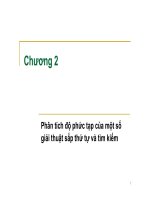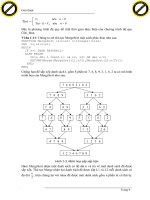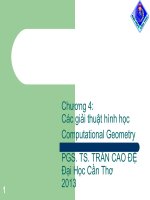Slide phân tích và thiết kế giải thuật chap2 divide and conquer
Bạn đang xem bản rút gọn của tài liệu. Xem và tải ngay bản đầy đủ của tài liệu tại đây (250.64 KB, 43 trang )
.c
om
du
o
ng
th
an
co
ng
Chapter 2
cu
u
Divide-and-conquer
1
CuuDuongThanCong.com
/>
u
du
o
ng
th
an
co
ng
“Divide-and-conquer” strategy
Quicksort
Mergesort
External sort
Binary search tree
cu
1.
2.
3.
4.
5.
.c
om
Outline
2
CuuDuongThanCong.com
/>
Divide-and-conquer strategy
.c
om
ng
co
an
th
ng
A problem’s instance is divided into several smaller
instances of the same problem.
The smaller instances are solved (typically recursively,
though sometimes non-recursively).
The solutions obtained for the smaller instances are
combined to get a solution to the original problem.
du
o
Binary search is an example of divide-and-conquer strategy.
The divide-and-conquer strategy is diagrammed in the
following figure, which depicts the case of dividing a problem
into two smaller subproblems.
u
The best well-known general algorithm design strategy
Divide-and-conquer algorithms work according to the following
steps:
cu
3
CuuDuongThanCong.com
/>
Divide-and-conquer
ng
.c
om
problem of size n
subproblem 2
of size n/2
du
o
Solution of
subproblem 2
cu
u
Solution of
subproblem 1
ng
th
an
co
subproblem 1
of size n/2
Solution to the original
4
CuuDuongThanCong.com
/>
2. Quick sort
.c
om
The basic algorithm of Quick sort was invented in 1960 by
C. A. R. Hoare.
du
o
ng
th
an
co
ng
Quicksort exhibits the spirit of “divide-and-conquer”
strategy.
Quicksort is popular because it is not difficult to
implement.
Quicksort requires only about NlgN basic operations on
the average to sort N items.
cu
u
The drawbacks of Quick sort are that:
- it is recursive
- it takes about N2 operations in the worst-case
- it is fragile.
5
CuuDuongThanCong.com
/>
Basic algorithm of Quicksort
co
ng
.c
om
Quicksort is a “divide-and-conquer” method for sorting. It
works by partitioning the input file into two parts, then
sorting the parts independently. The position of the partition
depends on the input file.
The algorithm has the following recursive structure:
cu
u
du
o
ng
th
an
procedure quicksort1(left,right:integer);
var i: integer;
begin
if right > left then
begin
i:= partition(left,right);
quicksort(left,i-1);
quicksort(i+1,right);
end;
end;
CuuDuongThanCong.com
6
/>
Partitioning
du
o
ng
th
an
co
ng
.c
om
The crux of Quicksort is the partition procedure, which must
rearrange the array to make the following three
conditions hold:
i) the element a[i] is in its final place in the array for some i
ii) all the elements in a[left], ..., a[i-1] are less than or equal
to a[i]
iii) all the elements in a[i+1], ..., a[right] are greater than or
equal to a[i]
52
56
cu
53 59 56
52 51 53
u
Example:
55
55
58
58
51
59
57
57
54
54
7
CuuDuongThanCong.com
/>
Example of partitioning
co
ng
.c
om
Assume that we select the first or the leftmost as the element
which will be placed at its final position (This element is
called the pivot element.
an
40 15 30 25 60 10 75 45 65 35 50 20 70 55
ng
th
40 15 30 25 20 10 75 45 65 35 50 60 70 55
15 30 25 20 10 35 45 65 75 50 60 70 55
35
15 30 25 20 10 40 45 65 75 50 60 70 55
cu
u
du
o
40
less than 40
sorted
greater than 40
What is the complexity of partitioning ?
CuuDuongThanCong.com
8
/>
Quicksort
cu
u
du
o
ng
th
an
co
ng
.c
om
procedure quicksort2(left, right: integer);
var j, k: integer;
begin
if right > left then
begin
j:=left; k:=right+1;
//start partitioning
repeat
repeat j:=j+1 until a[j] >= a[left];
repeat k:=k-1 until a[k]<= a[left];
if j< k then swap(a[j],a[k])
until j>k;
swap(a[left],a[k]); //finish partitioning
quicksort2(left,k-1);
quicksort2(k+1,right)
end;
end;
CuuDuongThanCong.com
9
/>
Complexity Analysis: the best case
an
co
ng
.c
om
The best case that could happen in Quicksort would be that
each partitioning stage divides the array exactly in half. This
would make the number of comparisons used by Quicksort
satisfies the recurrence relation:
CN = 2CN/2 + N.
cu
u
du
o
ng
th
The 2CN/2 covers the cost of sorting the two subfiles; the N is
cost of examining each element in the first partitioning stage.
From Chapter 1, we know that this recurrence has the
solution:
CN ≈ N lgN.
10
CuuDuongThanCong.com
/>
Complexity Analysis: the worst-case
.c
om
The worst-case of Quicksort happens when we apply Quicksort on
an already sorted array.
du
o
ng
th
an
co
ng
In that case, the 1st element requires n+1 comparisons to find that it
should stay at the first position. Besides, after partitioning, the left
subarray is empty and the right subarray consists of n – 1 elements.
So, in the next partitioning, the 2nd element requires n comparisons
to find that it should stay at the second position. And the same
situation continues like that.
cu
u
Therefore, the total number of comparisons is as follows:
(n+1) + n + … + 2 = (n+2)(n+1)/2 -1=
(n2 + 3n+2)/2 -1 = O(n2).
The complexity in the worst-case of Quicksort is O(n2).
11
CuuDuongThanCong.com
/>
Average-case-analysis of Quicksort
N
co
∑ (C
an
1
C N = ( N + 1) +
N
ng
.c
om
The precise recurrence formula for the number of
comparisons used by Quicksort for a random permutation of
N elements is:
+ C N −k )
th
k =1
k −1
cu
u
du
o
ng
for N ≥ 2 and C1 = C0 = 0
The (N+1) term covers the cost of comparing the partitioning
element with each of the others (two extra for where the pointers
cross). The rest comes from the observation that each element k is
likely to be partitioning element with probability 1/N after which
we are left with random files with size k-1 and N-k, respectively.
12
CuuDuongThanCong.com
/>
Note that, C0 + C1 + … + CN-1 is the same as
N
k =1
k −1
ng
∑ 2C
co
1
C N = ( N + 1) +
N
.c
om
CN-1 + CN-2 +… + C0, so we have
cu
u
du
o
ng
th
an
We can eliminate the sum by multiplying both sides by N and
subtracting the same formula for N-1:
NCN – (N-1) CN-1 = N(N+1) – (N-1)N + 2CN-1
This simplifies the recurrence:
HOW?
NCN = (N+1)CN-1 + 2N
13
CuuDuongThanCong.com
/>
ng
co
an
CN
C2 N
2
=
+∑
N + 1 3 k =3 (k + 1)
.c
om
Dividing both sides by N(N+1) give the recurrence as follows:
CN/(N+1) = CN-1/N + 2/(N+1)
= CN-2 /(N-1) + 2/N + 2/(N+1)
……….
th
= 3/3 + 2[1/4 + 1/5 +1/6 + …+1/(N+1)]
du
o
ng
= 2[1/2 +1/4 + 1/5 +1/6 + …+1/(N+1)]
cu
u
= 2[1 +1/2+ 1/3 +1/4 + 1/5 + …+1/(N+1) - 4/3]
CN/(N+1) ≈ 2(lnN – 4/3)
CN ≈ (2lnN -8/3)(N+1)
Finally, we have:
CN ≈ 2NlnN
14
CuuDuongThanCong.com
/>
.c
om
Average-case-analysis of Quicksort (cont.)
co
lnN = (log2N).(loge2) =0.69 lgN
ng
Note that:
th
an
2NlnN ≈ 1.38 NlgN.
du
o
ng
⇒ The average number of comparisons in Quicksort is
about only 38% higher that the best case.
cu
u
Property. Quicksort uses about 2NlnN comparison on the
average.
15
CuuDuongThanCong.com
/>
co
ng
Read the complexity analysis of:
.c
om
Exercises
an
Mergesort
du
o
cu
u
Binary search tree
ng
th
External sort
16
CuuDuongThanCong.com
/>
3. Mergesort algorithm
ng
.c
om
First, we examine a process, called merging, the
operation of combining two sorted files to make one
larger sorted file.
an
co
Merging
du
o
ng
th
In many data processing environments a large (sorted)
data file is maintained to which new entries are
regularly added.
cu
u
A number of new entries are appended to the (much
larger) main file, and the whole thing is resorted.
This situation is suitable for merging.
17
CuuDuongThanCong.com
/>
Merging
du
o
ng
th
an
co
ng
i:= 1; j :=1;
for k:= 1 to M+N do
if a[i] < b[j] then
begin c[k] := a[i]; i:= i+1 end
else begin c[k] := b[j]; j := j+1 end;
.c
om
Suppose that we have two sorted arrays a[1..M] and
b[1..N]. We wish to merge into a third array c[1..M+N].
cu
u
Note: The algorithm can use a[M+1] and b[N+1] as
sentinels which values larger than all the other keys.
Thanks to sentinels, when one array is exhausted, the loop
simply moves the rest of the other array into the c array.
18
CuuDuongThanCong.com
/>
The input consists of M+N elements in both arrays a and b.
Each comparison assigns one element to array c, which at
last consists of M+N elements. Therefore, the total number
of comparisons can not exceed M+N.
In other words, merging requires linear time:
O(N+M)
th
ng
du
o
u
cu
an
co
ng
.c
om
Complexity of merging two arrays
19
CuuDuongThanCong.com
/>
Mergesort
.c
om
Once we have a merging procedure, we can use it as the
basis for a recursive sorting procedure.
an
co
ng
To sort a given file, divide it in half, sort the two halves
(recursively), and then merge the two halves together.
du
o
ng
th
Mergesort exhibits the spirit of divide-and-conquer
strategy.
cu
u
The following algorithm sorts the array a[1..r], using an
auxiliary array b[1..r].
20
CuuDuongThanCong.com
/>
cu
u
du
o
ng
th
an
co
ng
.c
om
procedure mergesort(1,r: integer);
var i, j, k, m : integer;
begin
if r-1>0 then
begin
m:=(r+1)/2; mergesort(1,m); mergesort(m+1,r);
for i := m downto 1 do b[i] := a[i];
for j :=m+1 to r do b[r+m+1-j] := a[j];
for k :=1 to r do
if b[i] < b[j] then
begin a[k] := b[i] ; i := i+1 end
else begin a[k] := b[j]; j:= j-1 end;
end;
end;
21
CuuDuongThanCong.com
/>
A S O R T I N G E X A M P L E
Example: Sorting an
array of single
characters
A S
.c
om
O R
A O R S
ng
I T
co
G N
an
G I N T
du
o
E X
ng
th
A G I N O RS T
A M
cu
u
A E M X
L P
E L P
A E E L M P X
A A E E G I L M N O P R S T X
CuuDuongThanCong.com
22
/>
Complexity of Mergesort
.c
om
Property 2.1: Mergesort requires about NlgN
comparisons to sort any file of N elements.
an
co
ng
For the recursive algorithm of mergesort, the number of
comparisons is described by the recurrence:
th
CN = 2CN/2 + N, with C1 = 0.
u
CN ≈ N lg N
du
o
ng
We know from Chapter 1 that:
cu
Property 2.2: Mergesort uses extra space proportional to
N.
23
CuuDuongThanCong.com
/>
4. External Sorting
.c
om
Sorting the large files stored in secondary storage is called
external sorting. External sorting is very important in database
management systems (DBMSs).
co
ng
Block and Block Access
ng
th
an
The operating system breaks the secondary storage into blocks
with equal size. The size of blocks varies according to the
operating systems, but in the range between 512 to 4096 bytes.
du
o
Two basic operations on the files in secondary storage:
cu
u
- transfer a block from hard disk to a buffer in main
memory (read)
-
transfer a block from main memory to hard disk (write).
24
CuuDuongThanCong.com
/>
External Sorting (cont.)
co
ng
.c
om
When estimating the computational time of the algorithms
that work on files in hard disks, we must consider the
number of times we read a block to main memory or write a
block to secondary storage.
an
Such operation is called block access or disk access.
cu
u
du
o
ng
th
block = page
25
CuuDuongThanCong.com
/>









